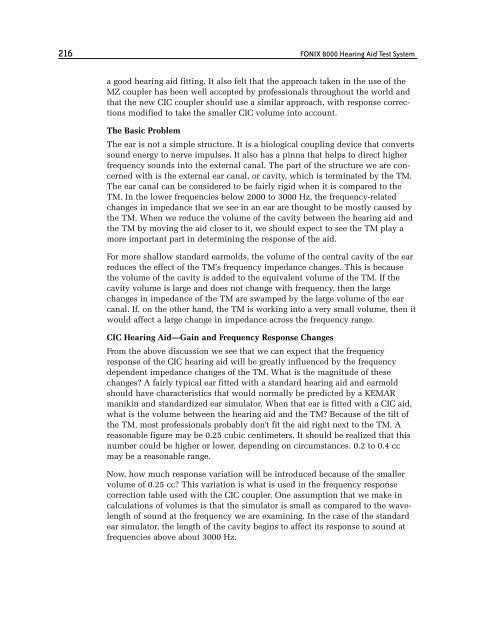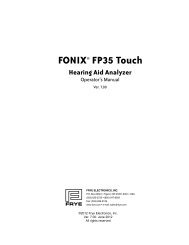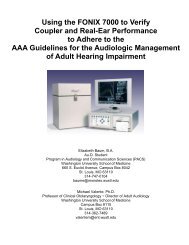FONIX® 8000 - Frye Electronics
FONIX® 8000 - Frye Electronics
FONIX® 8000 - Frye Electronics
Create successful ePaper yourself
Turn your PDF publications into a flip-book with our unique Google optimized e-Paper software.
216 FONIX <strong>8000</strong> Hearing Aid Test System<br />
a good hearing aid fitting. It also felt that the approach taken in the use of the<br />
MZ coupler has been well accepted by professionals throughout the world and<br />
that the new CIC coupler should use a similar approach, with response corrections<br />
modified to take the smaller CIC volume into account.<br />
The Basic Problem<br />
The ear is not a simple structure. It is a biological coupling device that converts<br />
sound energy to nerve impulses. It also has a pinna that helps to direct higher<br />
frequency sounds into the external canal. The part of the structure we are concerned<br />
with is the external ear canal, or cavity, which is terminated by the TM.<br />
The ear canal can be considered to be fairly rigid when it is compared to the<br />
TM. In the lower frequencies below 2000 to 3000 Hz, the frequency-related<br />
changes in impedance that we see in an ear are thought to be mostly caused by<br />
the TM. When we reduce the volume of the cavity between the hearing aid and<br />
the TM by moving the aid closer to it, we should expect to see the TM play a<br />
more important part in determining the response of the aid.<br />
For more shallow standard earmolds, the volume of the central cavity of the ear<br />
reduces the effect of the TM’s frequency impedance changes. This is because<br />
the volume of the cavity is added to the equivalent volume of the TM. If the<br />
cavity volume is large and does not change with frequency, then the large<br />
changes in impedance of the TM are swamped by the large volume of the ear<br />
canal. If, on the other hand, the TM is working into a very small volume, then it<br />
would affect a large change in impedance across the frequency range.<br />
CIC Hearing Aid—Gain and Frequency Response Changes<br />
From the above discussion we see that we can expect that the frequency<br />
response of the CIC hearing aid will be greatly influenced by the frequency<br />
dependent impedance changes of the TM. What is the magnitude of these<br />
changes? A fairly typical ear fitted with a standard hearing aid and earmold<br />
should have characteristics that would normally be predicted by a KEMAR<br />
manikin and standardized ear simulator. When that ear is fitted with a CIC aid,<br />
what is the volume between the hearing aid and the TM? Because of the tilt of<br />
the TM, most professionals probably don’t fit the aid right next to the TM. A<br />
reasonable figure may be 0.25 cubic centimeters. It should be realized that this<br />
number could be higher or lower, depending on circumstances. 0.2 to 0.4 cc<br />
may be a reasonable range.<br />
Now, how much response variation will be introduced because of the smaller<br />
volume of 0.25 cc? This variation is what is used in the frequency response<br />
correction table used with the CIC coupler. One assumption that we make in<br />
calculations of volumes is that the simulator is small as compared to the wavelength<br />
of sound at the frequency we are examining. In the case of the standard<br />
ear simulator, the length of the cavity begins to affect its response to sound at<br />
frequencies above about 3000 Hz.
















